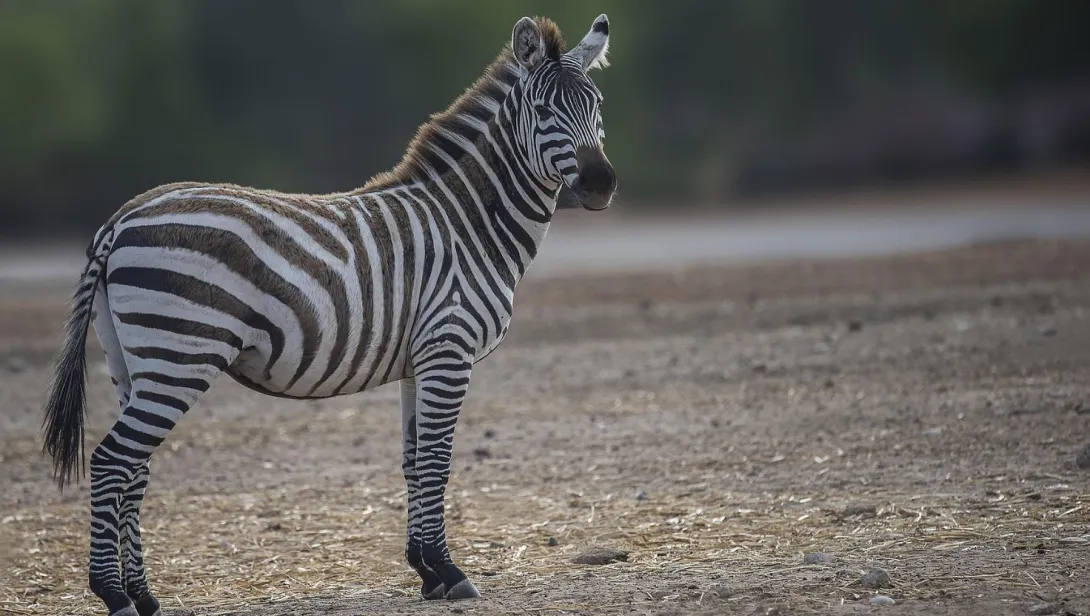Skip to main content
General Information
- The Zebra is a wild equine native to Africa and is closely related to horses and donkeys.
- They are best known for their distinct black-and-white striped coats, which serve as camouflage.
- There are three main species of zebra: Plains Zebra (Equus quagga), Mountain Zebra (Equus zebra), and Grevy’s Zebra (Equus grevyi).
- Zebras are herbivores that primarily feed on grasses but also eat leaves and bark.
- Unlike horses, zebras have never been truly domesticated due to their strong, unpredictable nature.
Physical Characteristics
- Zebras have muscular bodies built for speed and endurance.
- Their distinctive black and white stripes help in confusing predators and regulating body temperature.
- No two zebras have the same stripe pattern, making each individual unique.
- They have large, powerful legs capable of delivering strong kicks to defend themselves.
- Zebras have a lifespan of about 20 to 30 years in the wild and longer in captivity.
Habitat and Adaptation
- Zebras primarily inhabit grasslands, savannas, and open woodlands across Africa.
- Plains zebras are the most widespread, while Mountain zebras prefer rocky terrains.
- Zebras are highly adaptable and can survive in areas with limited water sources.
- They migrate in search of food and water, often traveling great distances.
- Zebras have excellent night vision, which helps them detect predators even in darkness.
Diet and Feeding Behavior
- Zebras are grazing herbivores that feed mainly on grass, shrubs, and bark.
- They have strong teeth and jaws to chew tough vegetation.
- Zebras need to drink water daily and often live near water sources.
- They can digest low-quality food better than domestic horses.
Social Behavior
- Zebras are highly social animals that live in groups called herds.
- A zebra herd is usually led by a dominant stallion, with several females and their offspring.
- They form strong family bonds and protect each other from predators.
- During migrations, zebras may form massive groups with other herbivores, such as wildebeests.
- Zebras communicate using vocalizations, body language, and facial expressions.
Reproduction and Lifespan
- The breeding season varies depending on the species and region.
- The gestation period lasts around 12 to 13 months, after which a single foal is born.
- Foals can stand and walk within an hour of birth, helping them escape predators.
- They rely on their mothers for milk and protection for several months.
- Zebras reach maturity at around 3 to 6 years of age.
Predators and Defense Mechanisms
- Zebras face threats from lions, hyenas, cheetahs, and wild dogs.
- Their primary defense mechanism is their speed, as they can run up to 65 km/h (40 mph).
- They rely on their sharp eyesight and strong hearing to detect predators early.
- Zebras use their powerful kick to injure or kill attackers.
- They often stay in groups, as predators find it harder to isolate an individual zebra.
Threats and Conservation
- Some zebra species, such as the Grevy’s zebra, are considered endangered due to habitat loss.
- Major threats include poaching, habitat destruction, and human-wildlife conflict.
- Conservation efforts include protected reserves and national parks in Africa.
- Eco-tourism plays a role in zebra conservation by funding wildlife protection.
Interesting Facts
- Each zebra’s stripe pattern is as unique as a human fingerprint.
- Zebras have a strong sense of loyalty to their herd and will defend injured members.
- They roll in dust and mud to protect their skin from parasites.
- Despite their horse-like appearance, zebras have a different skeletal structure and are harder to tame.
- The name "zebra" comes from the Portuguese word "zebro," meaning wild horse.
